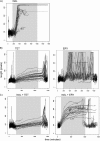Antagonism between bacteriostatic and bactericidal antibiotics is prevalent
- PMID: 24867991
- PMCID: PMC4135978
- DOI: 10.1128/AAC.02463-14
Antagonism between bacteriostatic and bactericidal antibiotics is prevalent
Abstract
Combination therapy is rarely used to counter the evolution of resistance in bacterial infections. Expansion of the use of combination therapy requires knowledge of how drugs interact at inhibitory concentrations. More than 50 years ago, it was noted that, if bactericidal drugs are most potent with actively dividing cells, then the inhibition of growth induced by a bacteriostatic drug should result in an overall reduction of efficacy when the drug is used in combination with a bactericidal drug. Our goal here was to investigate this hypothesis systematically. We first constructed time-kill curves using five different antibiotics at clinically relevant concentrations, and we observed antagonism between bactericidal and bacteriostatic drugs. We extended our investigation by performing a screen of pairwise combinations of 21 different antibiotics at subinhibitory concentrations, and we found that strong antagonistic interactions were enriched significantly among combinations of bacteriostatic and bactericidal drugs. Finally, since our hypothesis relies on phenotypic effects produced by different drug classes, we recreated these experiments in a microfluidic device and performed time-lapse microscopy to directly observe and quantify the growth and division of individual cells with controlled antibiotic concentrations. While our single-cell observations supported the antagonism between bacteriostatic and bactericidal drugs, they revealed an unexpected variety of cellular responses to antagonistic drug combinations, suggesting that multiple mechanisms underlie the interactions.
Copyright © 2014, American Society for Microbiology. All Rights Reserved.
Figures




References
-
- Hand K. 2006. Tuberculosis: pharmacological management. Hosp. Pharm. 13:81–85
-
- Mocroft A, Vella S, Benfield TL, Chiesi A, Miller V, Gargalianos P, d'Arminio Monforte A, Yust I, Bruun JN, Phillips AN, Lundgren JD, EuroSIDA Study Group 1998. Changing patterns of mortality across Europe in patients infected with HIV-1. Lancet 352:1725–1730. 10.1016/S0140-6736(98)03201-2 - DOI - PubMed
-
- WHO. 2010. WHO guidelines for the treatment of malaria, 2nd ed. WHO, Geneva, Switzerland
-
- Gilbert DN, Moellering RC, Eliopoulos GM, Chambers HF, Saag MS. (ed). 2010. The Sanford guide to antimicrobial therapy, 40th ed. Antimicrobial Therapy, Inc., Sperryville, VA
Publication types
MeSH terms
Substances
Grants and funding
LinkOut - more resources
Full Text Sources
Other Literature Sources
Medical

